
Tamiya 1/350 DKM Tirpitz
| KIT #: | 3 |
| PRICE: | $64.00 MSRP |
| DECALS: | none |
| REVIEWER: | Kevin Krueger |
| NOTES: | Gold Medal Models photo etch used. |

| HISTORY |
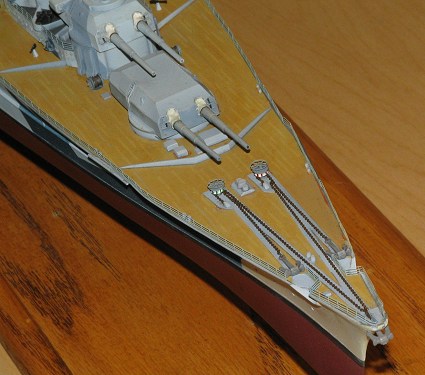 On 14 June 1936,
seven months after placing the order for the Bismarck, the Kriegsmarine
place another order, this time for the Tirpitz. The contract was placed
with Kriegsmarine Werft, Wilhemshaven as construction number S-128 and her
keel was laid on 2 November 1936. She was christened by Frau von Hassel,
daughter of Grand Admiral Alfred von Tirpitz, and launched on 1 April
1939. By July 1940 the British were well aware of her existence and
between 9 July 1940 and the time of her commissioning, no less than 15
bombing attacks were attempted by the British. Most of these were at
night, many were aborted due to bad weather, and none were successful.
However, the British did claim some hits and near misses on one raid but
this was never confirmed. She was commissioned on 25 February 1941, and
was placed under the command of Captain Friedrich Karl Topp. On 6 January
1942, Grand Admiral Erich Rader made his inspection and four days later (10
Jan) she was declared fully operational by Capt. Topp.
On 14 June 1936,
seven months after placing the order for the Bismarck, the Kriegsmarine
place another order, this time for the Tirpitz. The contract was placed
with Kriegsmarine Werft, Wilhemshaven as construction number S-128 and her
keel was laid on 2 November 1936. She was christened by Frau von Hassel,
daughter of Grand Admiral Alfred von Tirpitz, and launched on 1 April
1939. By July 1940 the British were well aware of her existence and
between 9 July 1940 and the time of her commissioning, no less than 15
bombing attacks were attempted by the British. Most of these were at
night, many were aborted due to bad weather, and none were successful.
However, the British did claim some hits and near misses on one raid but
this was never confirmed. She was commissioned on 25 February 1941, and
was placed under the command of Captain Friedrich Karl Topp. On 6 January
1942, Grand Admiral Erich Rader made his inspection and four days later (10
Jan) she was declared fully operational by Capt. Topp.
Sister ship to the Bismarck, she weighed approx. 52,600 tons fully loaded displacement. This was 1700 tons more than the Bismarck. With greater fuel capacity than the Bismarck, she had a range of 10,200 nm. Her Brown-Boveri turbines produced 138,000 shp and a maximum speed of 29 kts. Her main battery consisted of eight 15 in. (38 cm) L47 naval rifles. These main guns fired a shell that weighed 1759 lbs (798 kg) at a rate of three rounds per minute. She could hold her own against any of the King George V class battleships of the Royal Navy.
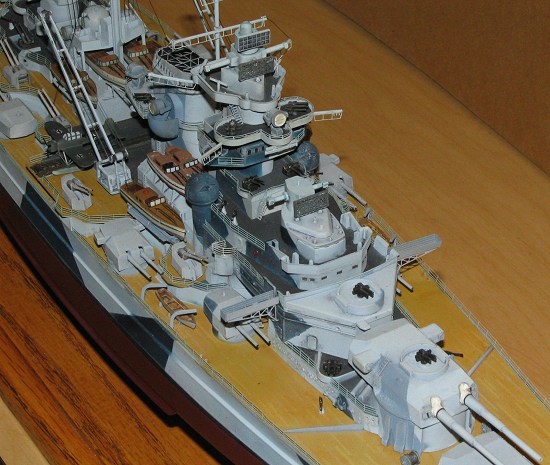 Her first combat
action came early in March 1942 against allied convoys. It was called
"Operation Sportpalast" and was intended to intercept convoys PQ-12 and
QP-8. However, due to bad weather, the German battle group failed to make
contact with the convoys. Next came "Operation Rosselsprung" the first
week of July, 1942. Together with 16 other ships, Tirpitz was to
participate in action against convoys PQ-17 and QP-13. The British, very
much aware of the thorn in her side the Tirpitz was, devised a plan to lure
her out. The convoy consisted of 33 merchant vessels, 21 escorts, a
cruiser force, and the British Home Fleet bolstered by the U.S.S.
Washington. Once the Germans located the convoy and launched attacks with
aircraft, the British Admiralty issue an incredible order. The escorts and
cruiser force were ordered to withdraw and the convoy was ordered to
disperse and scatter. The British Home Fleet, which trailed the convoy by
some 200 miles, could do nothing. The German U-boats cleaned up on the
unprotected convoy and only 11 ships made it to Murmansk. The Tirpitz
ended up sitting out the battle in a Norwegian fjord.
Her first combat
action came early in March 1942 against allied convoys. It was called
"Operation Sportpalast" and was intended to intercept convoys PQ-12 and
QP-8. However, due to bad weather, the German battle group failed to make
contact with the convoys. Next came "Operation Rosselsprung" the first
week of July, 1942. Together with 16 other ships, Tirpitz was to
participate in action against convoys PQ-17 and QP-13. The British, very
much aware of the thorn in her side the Tirpitz was, devised a plan to lure
her out. The convoy consisted of 33 merchant vessels, 21 escorts, a
cruiser force, and the British Home Fleet bolstered by the U.S.S.
Washington. Once the Germans located the convoy and launched attacks with
aircraft, the British Admiralty issue an incredible order. The escorts and
cruiser force were ordered to withdraw and the convoy was ordered to
disperse and scatter. The British Home Fleet, which trailed the convoy by
some 200 miles, could do nothing. The German U-boats cleaned up on the
unprotected convoy and only 11 ships made it to Murmansk. The Tirpitz
ended up sitting out the battle in a Norwegian fjord.
The Tirpitz never did participate in any large scale combat operations. She spent the remainder of the war in and out of Norwegian fjords. She did however keep a significant portion of the British Home Fleet at bay in case she ever attempted a breakout into the Altantic. The British launched numerous air attacks and even some clandestine naval operations in an attempt to sink the mighty ship. Finally, in mid November, 1944, the Tirpitz succumbed to an aerial bombardment by Lancasters using "Tallboys" in which she was struck three times and suffered from near misses. She capsized in waters near Tromso, Norway. From 1948 thru 1957 the wreckage was cut up and sold for scrap.
| THE KIT |
I bought this kit a few years ago and it has sat in the box collecting dust along with my other 1/350 scale ships. Many of my non-modeling friends kept bugging me about building one of these 1/350 scale Tamiya ships. We all know these people, the ones that swoon all over the work that you do but then tell you that they don't have the patience for such a hobby. Anyway, I said enough is enough and launched head long into building this model. For simplicity's sake I will refer to the different sub-assemblies as they are named in the instructions.
The kit is molded in a neutral gray plastic. Mold seams were minimal and flash was non-existent. Molding is crisp and the instructons are clear and easy to understand. One has the option of a motorized version or a display version. I chose the latter.
| CONSTRUCTION |
 I started by
drilling the portholes in the ship's hull and superstructure pieces. The
portholes for the gun deck are not there nor are they marked. The Gold
Medal Models (GMM) photo etch (PE)set provides good instructions on
placement of the holes and the corresponding PE piece. The molded in deck
chains were then scraped and removed from the front deck and the three deck
pieces were prepared for painting. Next, the barrels on the main 15" guns
(38 cm guns for those of you on the metric system) were drilled and set
aside. Blast bags were added to the main guns during the assembly phase
by using the technique of aluminum foil and white glue. I assembled the
rest of the kit according to the instructions, however, I did not
apply any PE piece that was a replacement for the kit part. The PE pieces
that did go on were the Range Finder Hoods, Armored Windows, Hangar Doors,
Ladders, et al. All the pieces that dressed up a regular kit part was
added at the time of construction of that particular part. PE parts left
off were the Funnel Cranes, Bridge Wings, FuMo Radars, and Funnel Grill. *
(see note at bottom) Attaching these pieces too soon enhances the likely
hood that they will get bent sometime during construction. The only
exception to this was the aircraft catapult. The aircraft catapult is a
separate photo etch piece that replaces the kit part K-18. The catapult
portion of the gun deck on the Tirpitz
I started by
drilling the portholes in the ship's hull and superstructure pieces. The
portholes for the gun deck are not there nor are they marked. The Gold
Medal Models (GMM) photo etch (PE)set provides good instructions on
placement of the holes and the corresponding PE piece. The molded in deck
chains were then scraped and removed from the front deck and the three deck
pieces were prepared for painting. Next, the barrels on the main 15" guns
(38 cm guns for those of you on the metric system) were drilled and set
aside. Blast bags were added to the main guns during the assembly phase
by using the technique of aluminum foil and white glue. I assembled the
rest of the kit according to the instructions, however, I did not
apply any PE piece that was a replacement for the kit part. The PE pieces
that did go on were the Range Finder Hoods, Armored Windows, Hangar Doors,
Ladders, et al. All the pieces that dressed up a regular kit part was
added at the time of construction of that particular part. PE parts left
off were the Funnel Cranes, Bridge Wings, FuMo Radars, and Funnel Grill. *
(see note at bottom) Attaching these pieces too soon enhances the likely
hood that they will get bent sometime during construction. The only
exception to this was the aircraft catapult. The aircraft catapult is a
separate photo etch piece that replaces the kit part K-18. The catapult
portion of the gun deck on the Tirpitz
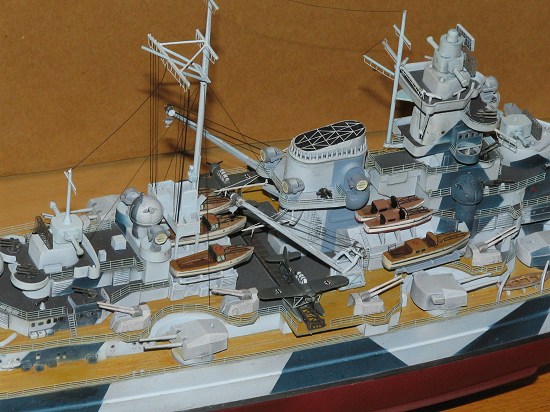 overhangs the main deck and one of
the small differences between the Tirpitz and the Bismarck. Therefore, you
must cut grooves into the overhanging portion of the gun deck to properly
accept the photo etch aircraft catapult.
overhangs the main deck and one of
the small differences between the Tirpitz and the Bismarck. Therefore, you
must cut grooves into the overhanging portion of the gun deck to properly
accept the photo etch aircraft catapult.
Before I attached the main deck to the hull, I drilled two holes in the bottom of the hull in order to mount the model on it's base. The two mounts are nothing more than a couple of lamp phineals and are secured to the ship's hull using JB Weld. I found this to be a great advantage as I was able to handle the base and not the model. I added the major assemblies as per instructions, leaving off some of the smaller pieces until last. The anchor chains were replaced with Campbell's Model Railroad Chains. The PE bridge wings and the radars were some of the last pieces to be attached. I dressed up the AR-196's with their photo etch parts and by the time I attached them to the ship, the only thing left to do was the railing. The PE railing around the main deck was added in approx. two inch segments. The only thing left after the railing to install was the rigging. Tamiya has included the rigging instructions and they appear not to be too difficult. I am not finished rigging this model yet and I apologize to the readers for displaying an unfinished model on Modeling Madness. However, certain circumstances dictated the timing of this and it couldn't be helped.
| COLORS & MARKINGS |
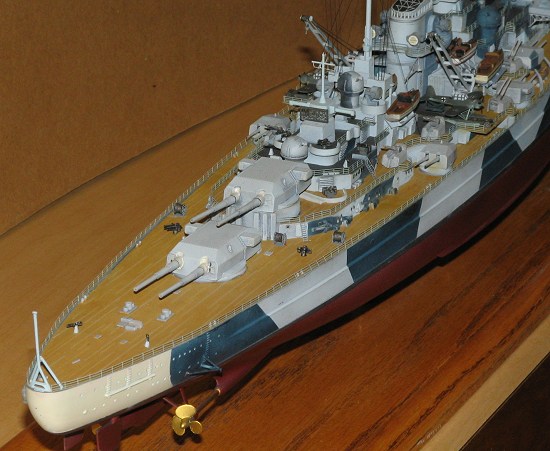 Painting this
model was actually one continuous process. I found that unlike aircraft or
armor where one can assemble the kit and then paint the exterior as needed,
I could not use that approach on this model. This would have to be done in
phases during construction. I wanted to represent the camouflage scheme
of July 1942 and "Operation Rosselsprung". The first thing I painted was
the deck. I used a technique I learned from Rusty White about 15 years
ago. I gave the deck a base color coat, then applied thin strips of mask,
lightly sprayed it with a slightly darker coat, applied more strips of
mask, and dusted it again with a even slightly darker coat again. The
result is a wood planking effect for the deck. For the hull, I found
Tamiya Hull Red to be too dark. I mixed my Hull Red with regular Flat Red
at a 50/50 ratio and got very pleasing results. Another problem I ran
encountered was that Tamiya only gives the paint scheme for the starboard
side. I had to do some digging to get the correct scheme for the port side
and this is where the websites really came in handy. The rest of the ship
(save for the AR-196's) was painted using WEMs (White Ensign Models)
Kriegsmarine colors KM 06, KM 07, KM 08, and KM 09. The white bow and
stern was painted with Gunze's Off White which has a slight grayish tint.
Obviously there was quite a bit of masking while painting this kit and I
assembled and painted one sub-assembly at a time. Most parts were given a
wash and highlight before being attached to the ship. Oh yeah, one more
thing, a ship this size requires a lot of masking tape....have plenty on
hand.
Painting this
model was actually one continuous process. I found that unlike aircraft or
armor where one can assemble the kit and then paint the exterior as needed,
I could not use that approach on this model. This would have to be done in
phases during construction. I wanted to represent the camouflage scheme
of July 1942 and "Operation Rosselsprung". The first thing I painted was
the deck. I used a technique I learned from Rusty White about 15 years
ago. I gave the deck a base color coat, then applied thin strips of mask,
lightly sprayed it with a slightly darker coat, applied more strips of
mask, and dusted it again with a even slightly darker coat again. The
result is a wood planking effect for the deck. For the hull, I found
Tamiya Hull Red to be too dark. I mixed my Hull Red with regular Flat Red
at a 50/50 ratio and got very pleasing results. Another problem I ran
encountered was that Tamiya only gives the paint scheme for the starboard
side. I had to do some digging to get the correct scheme for the port side
and this is where the websites really came in handy. The rest of the ship
(save for the AR-196's) was painted using WEMs (White Ensign Models)
Kriegsmarine colors KM 06, KM 07, KM 08, and KM 09. The white bow and
stern was painted with Gunze's Off White which has a slight grayish tint.
Obviously there was quite a bit of masking while painting this kit and I
assembled and painted one sub-assembly at a time. Most parts were given a
wash and highlight before being attached to the ship. Oh yeah, one more
thing, a ship this size requires a lot of masking tape....have plenty on
hand.
| CONCLUSIONS |
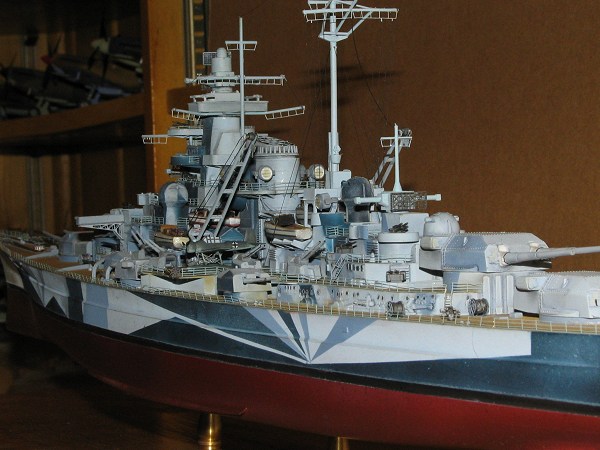 Overall, I would
have to rate this kit good to execellent. The kit's one major shortcoming
is the out of scale anti-aircraft guns. Had I been able to afford an
aftermarket set, I would have used one as the kit sorely needs it. White
Ensign Models makes what looks like a wonderful set of AA guns for the
1/350 Bismarck/Tirpitz. Although I would not recommend a kit like this to
a youngster for his/her first model, there is no reason at all why someone
with average modeling skills as myself can't build one of these ships. The
fit is good and the instructions are easy to follow. If you are
considering building one of these ships, I recommend purchasing a photo
etch set to go along with it. They are not that difficult to work with.
Want proof? This is my first 1/350 scale ship I've built and only my
second ship overall.
Overall, I would
have to rate this kit good to execellent. The kit's one major shortcoming
is the out of scale anti-aircraft guns. Had I been able to afford an
aftermarket set, I would have used one as the kit sorely needs it. White
Ensign Models makes what looks like a wonderful set of AA guns for the
1/350 Bismarck/Tirpitz. Although I would not recommend a kit like this to
a youngster for his/her first model, there is no reason at all why someone
with average modeling skills as myself can't build one of these ships. The
fit is good and the instructions are easy to follow. If you are
considering building one of these ships, I recommend purchasing a photo
etch set to go along with it. They are not that difficult to work with.
Want proof? This is my first 1/350 scale ship I've built and only my
second ship overall.
Full Speed Ahead !!!
February 2005
* Note...For photo etch purposes, I purchased a "Hold & Fold" tool a couple of years ago. Although not required, it can help a modeler with the finer aspects of bending PE parts. It made the task of working with photo etch parts significantly easier and I would recommend one if you have the means. "Etch Mate" is a similar tool and is available through CRM hobbies.
Kit and PE set courtesy of my bank account.
Special thanks to Drew Nix, Kevin Powers, and Scott Van Aken for their contributions toward the success of this project.
| REFERENCES |
Battleship "Tirpitz" Siegfried Breyer Schiffer Publications
German Battleships of World War Two in Action Robert C. Stern Squadron/Signal Publications
Copyright ModelingMadness.com
If you would like your product reviewed fairly and fairly quickly, please contact the editor or see other details in the Note to Contributors.